|
|
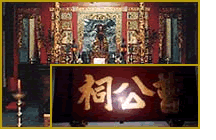 Fongshan City Office is located on Caogong Road. The road is about 600m long and is named after Magistrate Jin Cao of the Qing Dynasty. Cao was a great water conservancy specialist and an official who loved his people has his children of his own. It is said that Cao built cannels to carry water from the Gaoping River to irrigate crops in Fongshan County. To commemorate Cao’s deeds for the locals, descendents erected the Caogong Shrine to worship him. In 1992, people said that the Jade Emperor made an imperial decree to promote Caogong Shrine into the Caogong Temple. Believers thus built an idol of Cao and changed the name of the shrine into Caogong Temple. Also, Caogong Elementary School was built to commemorate Cao. Fongshan City Office is located on Caogong Road. The road is about 600m long and is named after Magistrate Jin Cao of the Qing Dynasty. Cao was a great water conservancy specialist and an official who loved his people has his children of his own. It is said that Cao built cannels to carry water from the Gaoping River to irrigate crops in Fongshan County. To commemorate Cao’s deeds for the locals, descendents erected the Caogong Shrine to worship him. In 1992, people said that the Jade Emperor made an imperial decree to promote Caogong Shrine into the Caogong Temple. Believers thus built an idol of Cao and changed the name of the shrine into Caogong Temple. Also, Caogong Elementary School was built to commemorate Cao. |
|
|
|
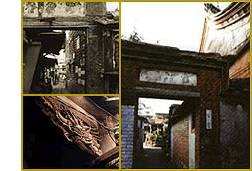 Located by the Chenghuang Temple in Fonggang Village, Fongyi Tutorial Academy was assigned as a Class 3 historical monument in 1985. It was built in 1814 (the 19th Year of Emperor Jiaqing’s Regime) by recommended candidate for the imperial examination Ting-cin Jhang with donations of money and land initiated by Magistrate Sing WU. The college has a total of 37 rooms. It was called a college because it was not the standard school in the education system of that time, like a private school today. Located by the Chenghuang Temple in Fonggang Village, Fongyi Tutorial Academy was assigned as a Class 3 historical monument in 1985. It was built in 1814 (the 19th Year of Emperor Jiaqing’s Regime) by recommended candidate for the imperial examination Ting-cin Jhang with donations of money and land initiated by Magistrate Sing WU. The college has a total of 37 rooms. It was called a college because it was not the standard school in the education system of that time, like a private school today.
The Academy has many special architectural landscapes. For exampling, the screen wall facing the front gate is like the screen design in modern buildings. The stone drums decorated with two dragons standing on both sides of the main entrance display the fastidious and crafty design of the academy. At present, the academy is on the priority monument repair list of KSCG. The illegal building problems will be solved first. It is believed that the glory of Fongyi Tutorial Academy will revive in the very near future. |
|
|
|
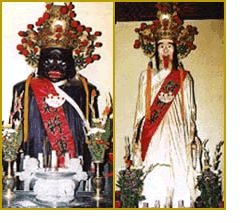 Fongshan Chenghuang (City God) Temple behind Caogong Elementary School and in the west of Fongyi Tutorial Academy was built in 1800 (the 5th Year of Emperor Jiaqing’s Regime), about 12 years after the building of the city in 1788. After the magistrate office was moved to the new city, it needed a new city god temple to administer the living and under worlds together with the magistrate. The temple was refurbished by the imperial examination candidate Chun-hua WU in 1859 (the 9th Year of Emperor Xianfeng’s Regime). Fongshan Chenghuang (City God) Temple behind Caogong Elementary School and in the west of Fongyi Tutorial Academy was built in 1800 (the 5th Year of Emperor Jiaqing’s Regime), about 12 years after the building of the city in 1788. After the magistrate office was moved to the new city, it needed a new city god temple to administer the living and under worlds together with the magistrate. The temple was refurbished by the imperial examination candidate Chun-hua WU in 1859 (the 9th Year of Emperor Xianfeng’s Regime).
In Chinese culture, people believe that the city god controls the payback of our good and evil deeds in this life and good and bad lucks. Therefore, there are two exclusive artifacts in the city god temple: There Your Are horizontal inscribed wooden board and a large abacus. The board with characters read “There Your Are” means that we must report to the city god sooner or later. The large abacus represents how our good and evil deeds are calculated. When seeing these two artifacts, people will understand what to do next.
Also, there is the Introduction to Chenghuang and History of Chenghuang Temple inscribed on wooden boards in a cute and lovely style different from the stone tablets we usually seen. Seeing that the temple needed repair and was at risk of collapse after long years of use, local gentlemen initiated the renovation project of the temple in 1967. The bald walls and broken tiles in the past have turned out to be the painted columns and sculptured beams we see today. Both interior and exterior are resplendent and magnificent, taking on an altogether new aspect and attracting a large number of pilgrims. |
| |
|
|
|
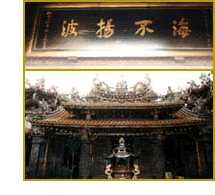 Located at the corner of Sanmin Road and Shuangcih Street, Shuangcih Pavilion was originally called Taihou Temple and worshipped Avalokitesvara, locals refer it to as Mazu Temple or the Grand Temple. A front hall was added in 1753 (the 18th Year of Emperor Qianlong’s Regime) where people began to worship Tianshanshengmu (Heavenly Holy Mother, aka of Mazu), and Avalokitesvara was worshipped in the rear hall. As both deities are female and merciful, believers thus changed the name of the temple from Tianhou into Shuangcih (two merciful goddesses). Located at the corner of Sanmin Road and Shuangcih Street, Shuangcih Pavilion was originally called Taihou Temple and worshipped Avalokitesvara, locals refer it to as Mazu Temple or the Grand Temple. A front hall was added in 1753 (the 18th Year of Emperor Qianlong’s Regime) where people began to worship Tianshanshengmu (Heavenly Holy Mother, aka of Mazu), and Avalokitesvara was worshipped in the rear hall. As both deities are female and merciful, believers thus changed the name of the temple from Tianhou into Shuangcih (two merciful goddesses).
In terms of time, Shuangcih Pavilion was built earlier than Longshan Temple. Before the addition of the front hall, the pavilion has been remodeled for four times in 1818 (the 23rd Year of Emperor Jiaqing’s Regime), 1828 (the 8th Year of Emperor Daoguang’s Regime), 1887 (the 13th Year of Emperior Guangxu’s Regime) and 1972 respectively. As the original style has gone, Longshan Temple becomes a Class 2 historical monument, while Shuangcih Pavilion is a modern building in terms of monumental value. However, a couplet inscribed on wooden boards made during Emperor Jiaqing’s Regime is still hanging in the front hall, witnessing the historical past of the pavilion. |
| |
|
|
|
 Built in 1765 (the 30th Year of Emperor Qianlong’s Regime), this academy monument has been assigned as a Class 2 historical monument. It is said that when a native of Fujian came to Taiwan with the burning incense of Avalokitesvara. As he was thirsty, he hang the incense on a guava tree near him and took some water from the ancient well at the location of the temple. When he left, he forgot to take the incense with him. As the incense gave out light every night, people believed that Avalokitesvara was making her presence. Therefore, they sculptured the guava tree in the image of Avalokitesvara and built a temple to worship the idol. At the entrance, there are wooden windows with the 壽-pattern sculpture decorated with bats and cranes. Built in 1765 (the 30th Year of Emperor Qianlong’s Regime), this academy monument has been assigned as a Class 2 historical monument. It is said that when a native of Fujian came to Taiwan with the burning incense of Avalokitesvara. As he was thirsty, he hang the incense on a guava tree near him and took some water from the ancient well at the location of the temple. When he left, he forgot to take the incense with him. As the incense gave out light every night, people believed that Avalokitesvara was making her presence. Therefore, they sculptured the guava tree in the image of Avalokitesvara and built a temple to worship the idol. At the entrance, there are wooden windows with the 壽-pattern sculpture decorated with bats and cranes.
A couplet read “Tung Men Pao Tai,Ling Tung Fong Tan東門保泰,靈通鳳彈” and “Nan Hai Liu Fong, Te Pu Hai Chiang南海流方,德普海疆” is hoisted in the unnoticeable corner on both sides. These are the features of Longshan Temple.。 |
| |
|
| |
Dongbian Gate and Dongfu Bridge |
|
|
 |
|
 In 1804 (the 9th Year of Emperor Jiaqing’s Regime), Magistrate Jaolin Wu built six gatehouses in Fongshan City. The minor east gate (Dongbian Gate) is one of them. After many years, only the minor east gate survives. Therefore, the east minor gate has a special position in time and space. The Dongfu Bridge spans across Dongmen River (Fongshan River). The boat-shape piers are over 200 years old. These hexagonally designed piers have the shape of a stem on both ends and were typical in the Qing Dynasty. Also, these piers are only found in Fongshan today, making them exceptionally valuable. In 1804 (the 9th Year of Emperor Jiaqing’s Regime), Magistrate Jaolin Wu built six gatehouses in Fongshan City. The minor east gate (Dongbian Gate) is one of them. After many years, only the minor east gate survives. Therefore, the east minor gate has a special position in time and space. The Dongfu Bridge spans across Dongmen River (Fongshan River). The boat-shape piers are over 200 years old. These hexagonally designed piers have the shape of a stem on both ends and were typical in the Qing Dynasty. Also, these piers are only found in Fongshan today, making them exceptionally valuable. |
| |
|
|
|
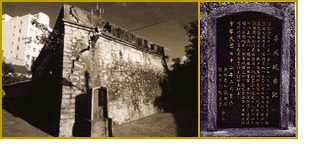 Pingcheng Fort is located right behind Caogong Temple. In 1838 (the 18th Year of Emperor Daoguang’s Regime), Magistrate Jin CAO built six forts in the four directions of the new Fongshan City to strengthen the city’s defensive power. Pingcheng Fort is located in the northwest. It is a 5m-tall square fort with ladders inside reaching the roof. To surface is paved with tiles with a horizontal granite stone tablet inscribed with the characters平成 in the facade. The structure is very robust. Pingcheng Fort is located right behind Caogong Temple. In 1838 (the 18th Year of Emperor Daoguang’s Regime), Magistrate Jin CAO built six forts in the four directions of the new Fongshan City to strengthen the city’s defensive power. Pingcheng Fort is located in the northwest. It is a 5m-tall square fort with ladders inside reaching the roof. To surface is paved with tiles with a horizontal granite stone tablet inscribed with the characters平成 in the facade. The structure is very robust. |
|
|
|
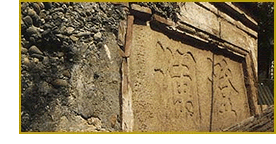 Chenglan Fort was build in 1838 (the 18th Year of Emperor Daoguang’s Regime) by Magistrate Jin CAO to strengthen the city’s defensive power. A Class 3 national historical monument, Chenglan Fort is located in the southwester corner of Fongshan City, i.e. the intersection of Lizi Street and Fusing Street. The foundation of the fort is in an irregular octagonal shape. A horizontal granite tablet inscribed with the characters read Chenglan (澄瀾) is still hanging on the facade, though it is blocked by Fude Temple in front of it, making it difficult to identify. Chenglan Fort was build in 1838 (the 18th Year of Emperor Daoguang’s Regime) by Magistrate Jin CAO to strengthen the city’s defensive power. A Class 3 national historical monument, Chenglan Fort is located in the southwester corner of Fongshan City, i.e. the intersection of Lizi Street and Fusing Street. The foundation of the fort is in an irregular octagonal shape. A horizontal granite tablet inscribed with the characters read Chenglan (澄瀾) is still hanging on the facade, though it is blocked by Fude Temple in front of it, making it difficult to identify.
|
|
|
|
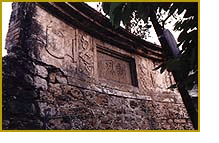 Syunfong Fort is located on Jhongshan Road, in the lane on the right of Longshan Temple at the southeastern corner of the East Gatehouse (Caoyang Gate). The wall of the fort is curved. It was built at the intersection of Fongshan River and the city moat, embracing the outlet of Fongshan River toward Siyucheng River. As it was the place where Han immigrants from China went ashore and business ships embarked, it was a strategically important hub. Syunfong Fort was built with pebbles. The horizontal stone tablet was embedded in the fort wall. There are clay scroll decorations on the left and right of the tablet. The craftsmanship is exquisite and artistic. Though the fort wall was long and winding, only some 10m survived today. Syunfong Fort is located on Jhongshan Road, in the lane on the right of Longshan Temple at the southeastern corner of the East Gatehouse (Caoyang Gate). The wall of the fort is curved. It was built at the intersection of Fongshan River and the city moat, embracing the outlet of Fongshan River toward Siyucheng River. As it was the place where Han immigrants from China went ashore and business ships embarked, it was a strategically important hub. Syunfong Fort was built with pebbles. The horizontal stone tablet was embedded in the fort wall. There are clay scroll decorations on the left and right of the tablet. The craftsmanship is exquisite and artistic. Though the fort wall was long and winding, only some 10m survived today. |
|
| |
|